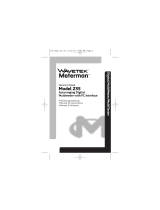
14
Lea primeramente: Información de seguridad
Asegúrese de entender y seguir cuidadosamente las instrucciones de operación.
Si el equipo no se utiliza de la manera especificada por IDEAL, la protección
que proporciona puede verse reducida.
ADVERTENCIAS
Para evitar posibles riesgos de electrocución, lesiones o la muerte, siga estas
instrucciones:
• No use el instrumento si el mismo parece estar dañado.
• Inspecciónelo visualmente para asegurarse de que la carcasa no esté fisurada
y que la parte trasera de la misma esté firmemente colocada en su sitio.
• Inspeccione y reemplace los cables si el aislamiento está dañado, hay piezas
metálicas expuestas o las sondas están fisuradas. Preste particular atención al
aislamiento de alrededor del conector.
• No use el instrumento si funciona en forma anormal, porque puede verse
reducida la protección.
• No use el instrumento durante tormentas eléctricas o con tiempo húmedo.
• No use el instrumento cerca de gases explosivos, polvo o vapor.
• No aplique al instrumento voltajes superiores al nominal.
• No use el instrumento sin la batería ni si la parte posterior de la carcasa no
está instalada correctamente.
• Retire los cables de prueba del circuito antes de desmontar la tapa de la
batería.
• No intente reparar esta unidad puesto que no tiene piezas reparables por el
usuario.
• Desconecte la alimentación eléctrica y descargue los capacitores antes de
medir resistencia, continuidad o aislamiento.
• Reemplace la batería tan pronto aparezca el indicador de batería con
poca carga, a fin de evitar lecturas falsas.
• Use los terminales, la función y el rango (alcance) apropiados para sus
medidas.
• Tenga cuidado, puesto que este instrumento produce un alto voltaje para
medir la resistencia de aislamiento.
• Cumpla los requisitos de seguridad locales y nacionales, incluido el uso de
equipos de protección personal apropiados.
Para protegerse, piense que “¡La seguridad primero!”:
• Los voltajes superiores a 30 VCA o 60 VCC representan un riesgo de electro-
cución, por lo que debe trabajar con precaución.
• Use equipos de protección personal apropiados, tales como gafas de seguri-
dad, máscaras faciales, guantes, calzado y/o alfombras aislantes.
+























